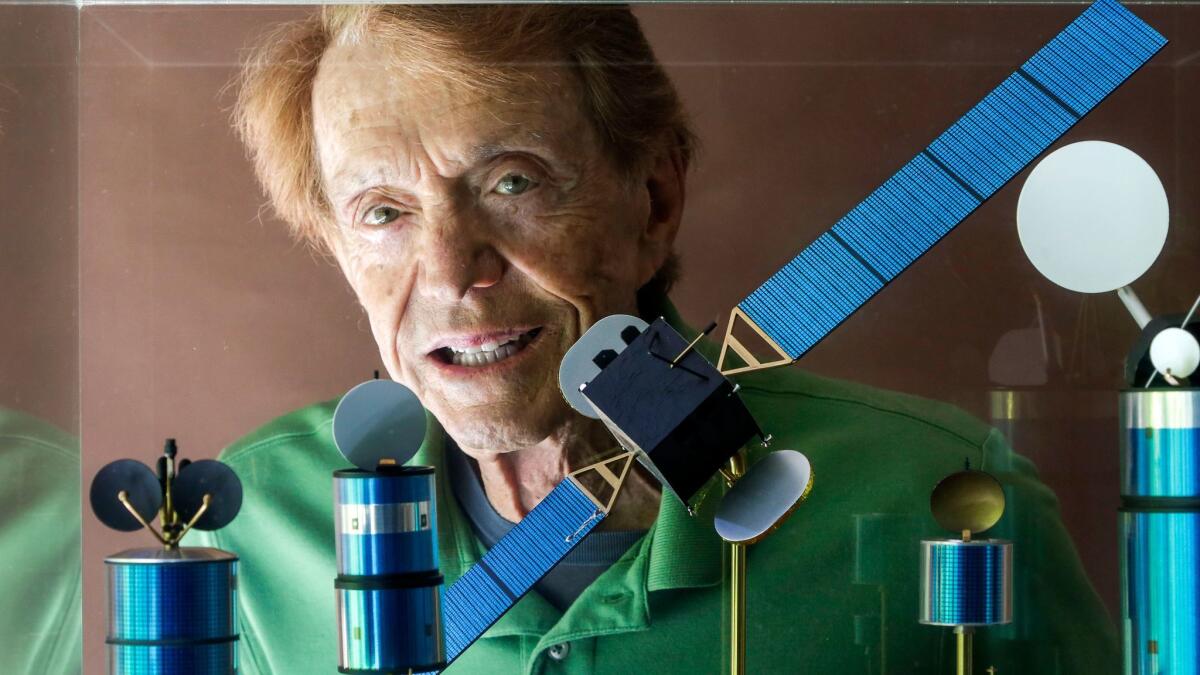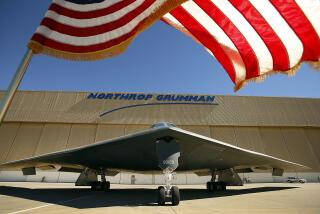Harold Rosen, creator of satellite that helped reshape life in Southern California, dies at 90

At a moment in the Cold War when it seemed the Soviet Union was eclipsing America in space, a young engineer at Hughes Aircraft was hatching an audacious plan to permanently surpass the communists.
What Harold Rosen imagined by the late 1950s was a lightweight satellite that could transmit telephone calls and video images around the world, providing connectivity between nations that at the time was only a farsighted dream.
By 1963, Rosen had succeeded in upending the world of science and engineering, overseeing the creation of the world’s first geosynchronous communications satellite and laying the foundation of a future multi-billion dollar industry that would be dominated by California.
Rosen died Monday at his home in Santa Monica at age 90. His death was confirmed by his wife, Deborah Castleman.
Of all the technological breakthroughs made in Los Angeles during the Cold War — the first supersonic jet fighter, the Apollo moon ship, stealth aircraft, the space shuttle, the Blackbird spy plane, the intercontinental ballistic missile system and much else — the creation of a communications satellite has had the largest and most enduring cultural, social and economic impact.
Rosen’s accomplishments in the early 1960s with the first satellite, which he dubbed Syncom, would hardly be his last act. In the decades to come, Rosen presided as the de facto chief scientist at Hughes Aircraft’s space and communications group in El Segundo, helping design the Hughes Satellite 376 and the Hughes Satellite 601, two of the most successful commercial spacecraft programs in history.
“Harold was the brilliant mind behind many of the developments that made Hughes so successful,” said Steve Dorfman, who was a president of the space group. “Harold was the go-to guy when new ideas were required or problems needed to be solved.”
For all his focused drive on engineering, Rosen had broad interests. Dorfman recalled that after he and Rosen were dispatched to deal with a technical crisis, they boarded a company jet to return home and, with a bloody mary at his side, Rosen quickly dove into a New York Times crossword puzzle he brought along.
Rosen had an innate ability to leap beyond conventional wisdom. In recent years he harbored serious doubts about tglobal warming, particularly the severity of the problem and the proposed solution of limiting greenhouse gas emissions. He believed any climate change crisis in the future could be contained with straightforward climate engineering or more elaborate space-based systems.
It was the knack for thinking outside the box that was essential to his vision for communications satellites. The Soviet Union had launched the world’s first satellite, Sputnik, in 1957. But all it could do was broadcast a simple beep. What Rosen wanted was a telephone switching station in space, one that could route thousands of telephone calls at a time when undersea copper cables carried only small numbers of calls.
The top American communications experts doubted that his idea for a satellite 22,000 miles in space would ever work. But Rosen never faltered in his conviction and recruited a team of engineers at Hughes to develop a 78-pound machine that would outflank the best that Ma Bell, the American Telephone and Telegraph Co., could muster. When Syncom was launched, its formal inauguration came in a two-minute telephone call placed by President John F. Kennedy to Nigerian Prime Minister Abubakar Tafawa Balewa.
The little Syncom has morphed into communications satellites the size of school buses, weighing more than 13,000 pounds, operating with solar wings the length of a basketball court and running electronics with more power than a typical house wired to the electrical grid. Electronic credit card authorizations, international television signals, email and social media — all the things that define modern connected culture — would not exist in many areas of the world without communications satellites.
Rosen would later win the Charles Stark Draper Prize, considered the Nobel Prize of engineering, which he shared with his rival John Pierce, a Bell Labs expert who in the 1950s had advocated low-Earth-orbit satellites. When he won the Goddard Memorial Trophy from the National Space Club in 2015, the somewhat shy engineer was mobbed by younger engineers and scientists at a reception in Washington, Castleman said.
Rosen continued to consult for the satellite operation, which was later acquired by Boeing, until late last year when a team of Boeing engineers came to Rosen’s house to discuss plans for a new type of high-power amplifier for future satellites.
Castleman, a former satellite engineer at Hughes and deputy assistant secretary of Defense during the Clinton administration, said her husband remained in good health until his death Monday. Rosen had suffered a minor stroke last year. “He was active until the end,” she said.
Rosen was born March 20, 1926, in New Orleans and attended Tulane University. He dithered over where to attend graduate school, but after reading a Life magazine story about beach parties in Southern California he decided on Caltech, where he earned a PhD in engineering.
Rosen is survived by Castleman and two sons, Rocky and Robert. Their mother, Rosetta, died in 1969. He is also survived by a brother, Benjamin Rosen.
Twitter: @rvartabedian
More to Read
Start your day right
Sign up for Essential California for the L.A. Times biggest news, features and recommendations in your inbox six days a week.
You may occasionally receive promotional content from the Los Angeles Times.







